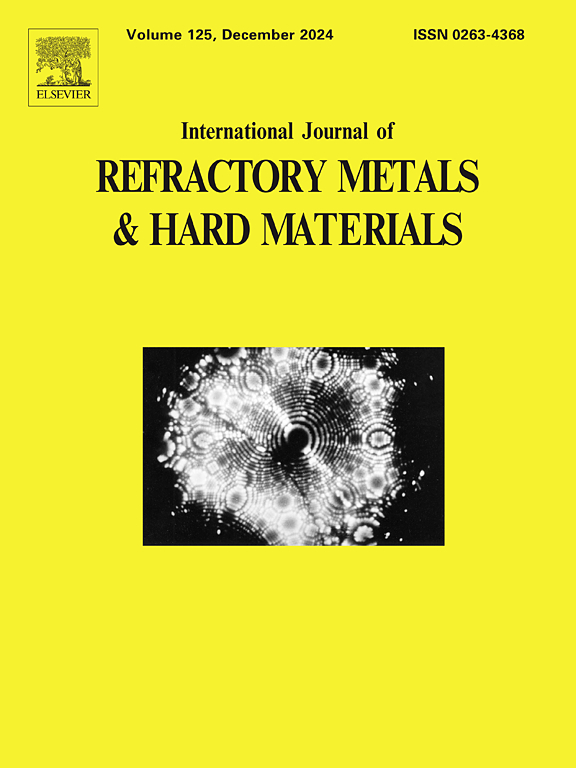Effect of gradient layer thickness on microstructure and properties of gradient polycrystalline diamond compact fabricated via material extrusion 3D printing technology
IF 4.6
2区 材料科学
Q2 MATERIALS SCIENCE, MULTIDISCIPLINARY
International Journal of Refractory Metals & Hard Materials
Pub Date : 2025-07-11
DOI:10.1016/j.ijrmhm.2025.107328
引用次数: 0
Abstract
Polycrystalline diamond compacts (PDCs) are extensively utilized in petroleum drilling, geological exploration, and high-performance machining tools. Notably, gradient structure has demonstrated significant efficacy in reducing interfacial residual stresses within PDCs, thereby enhancing the mechanical performance. However, investigation into the effect of gradient parameters on the microstructure and performance of PDCs has rarely been investigated in practice. This study utilized material extrusion 3D printing technology to manufacture gradient PDCs with different gradient layer thickness. Transition in microstructure and element distribution inside gradient layers were characterized with scanning electron microscopy and energy-dispersive spectroscopy. Subsequently, wear resistant and impact toughness of gradient PDCs and conventional PDC were systematically investigated via vertical turret lathe and drop-weight impact test. All gradient PDCs exhibited a counter-gradient distribution of diamond and tungsten carbide within their gradient layers, but the compositional gradient evolution rate progressively decreased with the increase of gradient layer thickness. Inhomogeneous cobalt diffusion induced the formation of Co-depleted zones with their spatial extent expanding progressively with increasing gradient layer thickness. WC grains in the gradient layer exhibited progressive homogeneous refinement from the cemented carbide substrate toward the PCD layer, which is closely related to the cobalt distribution. The gradient PDC including 8 gradient sublayers with a thickness of 0.1 mm demonstrated a 12.3 % enhancement in impact resistance and 22.7 % improvement in wear resistance compared to conventional PDC. The study results can provide valuable insights and guidance for the design of gradient structure for high-quality PDCs.
梯度层厚度对材料挤压3D打印技术制备的梯度聚晶金刚石致密体微观结构和性能的影响
聚晶金刚石压片广泛应用于石油钻井、地质勘探和高性能加工工具中。值得注意的是,梯度结构在减小pdc内部的界面残余应力,从而提高力学性能方面表现出了显著的效果。然而,在实际应用中,很少有研究梯度参数对pdc微观结构和性能的影响。本研究利用材料挤压3D打印技术制造不同梯度层厚度的梯度pdc。利用扫描电镜和能谱分析表征了梯度层内部的微观结构转变和元素分布。随后,通过立式转塔车床和落锤冲击试验,系统研究了梯度PDC和常规PDC的耐磨性和冲击韧性。各梯度pdc在其梯度层内均表现出金刚石和碳化钨的反梯度分布,但随着梯度层厚度的增加,组成梯度演化速率逐渐减小。随着梯度层厚度的增加,钴的非均匀扩散诱导贫钴带的形成,其空间范围逐渐扩大。梯度层WC晶粒从硬质合金基体向PCD层逐渐均匀细化,这与钴的分布密切相关。与常规PDC相比,包含8个厚度为0.1 mm的梯度亚层的梯度PDC的抗冲击性提高了12.3%,耐磨性提高了22.7%。研究结果可为高质量pdc的梯度结构设计提供有价值的见解和指导。
本文章由计算机程序翻译,如有差异,请以英文原文为准。
求助全文
约1分钟内获得全文
求助全文
来源期刊
CiteScore
7.00
自引率
13.90%
发文量
236
审稿时长
35 days
期刊介绍:
The International Journal of Refractory Metals and Hard Materials (IJRMHM) publishes original research articles concerned with all aspects of refractory metals and hard materials. Refractory metals are defined as metals with melting points higher than 1800 °C. These are tungsten, molybdenum, chromium, tantalum, niobium, hafnium, and rhenium, as well as many compounds and alloys based thereupon. Hard materials that are included in the scope of this journal are defined as materials with hardness values higher than 1000 kg/mm2, primarily intended for applications as manufacturing tools or wear resistant components in mechanical systems. Thus they encompass carbides, nitrides and borides of metals, and related compounds. A special focus of this journal is put on the family of hardmetals, which is also known as cemented tungsten carbide, and cermets which are based on titanium carbide and carbonitrides with or without a metal binder. Ceramics and superhard materials including diamond and cubic boron nitride may also be accepted provided the subject material is presented as hard materials as defined above.

 求助内容:
求助内容: 应助结果提醒方式:
应助结果提醒方式:


